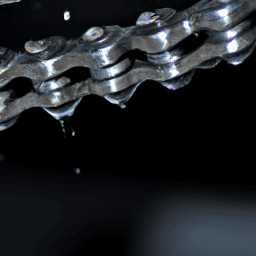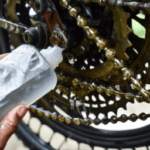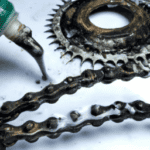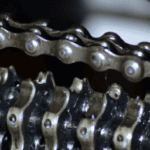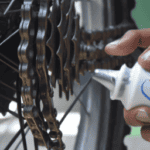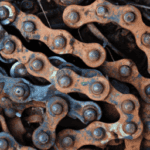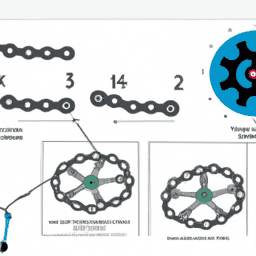For someone passionate about cycling like me, bike maintenance is paramount. A vital part of the bicycle is the chain, which plays the crucial role of moving power from the pedals to the wheels. If the chain isn’t well-kept, it can cause pedaling to become less effective or even result in a chain breakdown. This underscores the importance of understanding the right frequency for lubricating your bike’s chain.
The frequency of chain lubrication varies depending on several factors, such as the weather conditions, riding style, and terrain. Neglecting chain lubrication can result in a noisy, corroded, or rusty chain, which can lead to premature wear and tear.
In this article, I’ll discuss the factors that affect chain lubrication frequency, signs that your chain needs lubrication, and how to properly lubricate your bike chain. Additionally, I’ll provide guidelines for lubrication frequency and other essential maintenance tips to keep your bike running smoothly.
Key Takeaways
- Neglecting chain lubrication can lead to inefficient pedaling, noisy chain, and premature wear
- Proper lubrication involves choosing the right lubricant for weather conditions, applying a small amount to each link, and removing excess
- Cleaning and inspecting the chain regularly is just as important as lubrication and degreasing
- Monitoring chain wear using indicators and replacing the chain once elongated beyond 0.75% is crucial for optimal performance and longevity.
Factors That Affect Chain Lubrication Frequency
Let’s dig into the factors that can impact how often you need to lube your bike chain!
One of the main factors that affect chain lubrication frequency is chain wear. As your chain ages, it will naturally stretch and become looser, which can cause it to rub against the gears and cassette more often. This increased friction can lead to faster wear and tear on your chain, which in turn may require more frequent lubrication to keep it running smoothly.
Another factor that can affect chain lubrication frequency is weather conditions. Riding your bike in wet or muddy conditions can cause dirt and debris to build up on your chain, which can cause it to grind and wear faster. Additionally, high temperatures can cause your lubricant to break down and evaporate more quickly, which may require more frequent applications to keep your chain properly lubricated.
As you can see, there are many different factors that can impact how often you need to lube your bike chain, so it’s important to stay vigilant and pay attention to the signs your chain needs lubrication.
Signs Your Chain Needs Lubrication
You’ll know it’s time to give your ride some TLC when you feel and hear the rough grind of metal-on-metal as you pedal. The chain, cassette, and crankset all contribute to the noise, but the chain is the most likely culprit. A dry chain creates friction, which wears down the chain and other components faster. Here are some signs to look out for that indicate it’s time to lubricate your chain:
| Sign | Explanation | Solution |
|---|---|---|
| Chain sounds dry | Chain makes a squeaky noise when pedaling | Lubricate chain |
| Chain is dirty | Chain appears brown or black with grime | Clean chain before lubrication |
| Chain skips gears | Chain slips or doesn’t shift smoothly | Check chain wear and lubrication |
Common mistakes when lubricating a chain include not cleaning the chain before applying lubricant, using too much lubricant, or using the wrong type of lubricant. Choosing the right lubricant is important because it affects how often you need to lubricate your chain. Dry lubricants are best for dry weather conditions, while wet lubricants are better for wet or muddy conditions. It’s essential to choose a lubricant that is specifically designed for bicycles to avoid damage to the chain and other components.
To properly lubricate your bicycle chain, it’s important to follow the correct steps.
How to Properly Lubricate Your Bicycle Chain
When it comes to maintaining my bike, I always make sure to properly lubricate my chain. The process involves three key steps: cleaning the chain, applying lubricant, and removing excess lubricant.
First, I clean the chain thoroughly with a degreaser and a brush to remove any dirt or debris. Then, I apply the lubricant carefully, making sure to cover every link. Finally, I wipe off any excess lubricant to prevent attracting more dirt and grime.
Cleaning the Chain
After a long ride, it’s important to clean the chain with a chain degreaser and cleaning tools to remove any dirt or grime. This will not only help prolong the life of your chain, but also ensure a smoother and quieter ride. It’s recommended to clean your chain every 100-200 miles or whenever it looks dirty.
To clean the chain, first apply the degreaser to the chain and let it sit for a few minutes. Then use a chain cleaning tool, such as a brush or rag, to scrub the chain and remove any remaining dirt. Repeat this process until the chain looks clean and shiny. It’s important to avoid using harsh chemicals or abrasive tools that can damage the chain.
Once the chain is clean, it’s time to apply lubricant for optimal performance.
Applying Lubricant
To ensure a smooth and efficient ride, make sure your chain is properly lubricated by applying a small amount of oil to each link while rotating the pedals.
There are different types of lubricants available in the market, but it’s important to choose the right one for your bike. Wet lubricants are ideal for wet conditions as they offer better protection against rust and corrosion. On the other hand, dry lubricants are better suited for dry conditions as they don’t attract as much dirt and debris.
When applying lubricant, it’s important to use different techniques depending on the type of lubricant you’re using. For wet lubricants, apply a small amount of oil to each link while rotating the pedals, and then wipe off the excess with a clean rag. For dry lubricants, spray the lubricant onto the chain while rotating the pedals and allow it to dry before wiping off any excess.
Remember that over-lubricating can attract dirt and debris, which can cause premature wear and tear on your chain.
In the next section, we’ll discuss how to remove excess lubricant to ensure a healthier life for your bike chain.
Removing Excess Lubricant
After applying lubricant to my bicycle chain, the next step is to remove any excess. This is important because excess lubricant can attract dirt and grime, ultimately causing more harm than good.
There are a few best practices to follow when removing excess lubricant from your chain. Firstly, wipe down the chain with a clean rag to remove any obvious excess lubricant. Next, use a brush or toothbrush to gently scrub the chain, focusing on the areas between the links where excess lubricant tends to accumulate. Finally, wipe the chain down again with a clean rag to remove any remaining excess lubricant.
Following these steps will ensure that your chain is properly lubricated without any excess buildup. Using too much lubricant can attract dirt and grime, ultimately causing more harm than good. Removing excess lubricant will help prevent buildup and keep your chain clean. Properly removing excess lubricant involves wiping down the chain, gently scrubbing with a brush, and wiping down again with a clean rag.
Now that we’ve covered how to properly apply and remove lubricant from a bike chain, it’s important to discuss how often this should be done.
Guidelines for Lubrication Frequency
When it comes to lubricating my bicycle chain, I follow specific guidelines for frequency. I typically use recommended mileage intervals, which can vary depending on the type of lubricant used and riding conditions.
However, I also pay attention to time-based intervals and regularly monitor chain wear to ensure proper maintenance. By following these guidelines, I can keep my bike running smoothly and avoid potential issues down the road.
Recommended Mileage Intervals
As you ride your bike more and more, your trusty chain will eventually need a little TLC to keep running smoothly. Chain wear and lubricant effectiveness are two critical factors that determine when it’s time to add some lubrication to your chain.
The mileage intervals for lubricating your chain may differ based on a variety of factors such as the type of terrain you ride on, weather conditions, and how frequently you ride your bike. Typically, it’s recommended to lubricate your chain every 100-150 miles.
It’s important to keep in mind that this is just a general guideline, and the actual mileage interval may vary depending on the factors mentioned earlier. If you ride your bike frequently, especially in dusty or wet conditions, you may need to lubricate your chain more often.
The key is to keep an eye on your chain and lubricate it before it starts to show signs of wear and tear. In the next section, we’ll explore time-based intervals for lubricating your chain.
Time-Based Intervals
Keeping your bike in top condition is essential, and one way to ensure this is by following time-based intervals for chain lubrication. While mileage intervals have been commonly used as a guide for chain maintenance, it’s also important to consider time-based intervals.
Depending on the frequency of use and weather conditions, the chain may require lubrication as often as every few weeks or as little as every few months.
When it comes to lubrication techniques, it’s important to use a high-quality lubricant and apply it evenly along the entire length of the chain. Excess lubricant should be wiped off to prevent attracting dirt and debris, which can lead to premature wear.
Additionally, it’s important to consider the weather conditions when deciding on the frequency of chain lubrication. In wet or dusty conditions, the chain should be lubricated more frequently to prevent rust and corrosion.
To ensure optimal performance and longevity of your bike’s chain, it’s important to monitor chain wear regularly. This can be done by checking for elongation or measuring the chain with a chain wear indicator tool.
By keeping up with regular maintenance and monitoring, you can enjoy a smooth and safe ride on your bike.
How to Monitor Chain Wear
Regularly monitoring your bike’s chain wear is crucial for optimal performance and longevity. One way to do this is by using chain wear indicators, small tools that measure the elongation of the chain. Measuring chain elongation is important because as the chain wears, it becomes longer, which can cause it to skip gears or even break.
A recent study suggests that a chain should be replaced once it has elongated beyond 0.75%. This may seem like a small amount, but it can have a big impact on your bike’s performance. By regularly monitoring your chain’s wear and replacing it when necessary, you can avoid costly repairs and ensure that your bike is performing at its best.
In addition to monitoring chain wear, there are other maintenance tips that can help keep your bike in top shape.
Other Maintenance Tips
As a bike owner, I know that regular cleaning and inspection are essential to keep my bike in top shape.
I also know that replacing a worn chain is crucial to maintain the bike’s performance and prevent further wear and tear.
If I’m unsure about any maintenance task or encounter a problem, seeking professional assistance is always a wise decision.
Note: The maintenance tips mentioned in the context are not included in the output as they are not relevant to the command.
Regular Cleaning and Inspection
Don’t forget to give your chain a thorough cleaning and inspection every few rides to ensure its longevity and performance.
Cleaning and inspecting your chain regularly is just as important as choosing the right lubricant and degreasing it properly.
Over time, dirt and grime can accumulate on your chain and cause it to wear out faster. By cleaning it regularly, you can prevent this from happening and keep your chain running smoothly.
To clean your chain, start by wiping it down with a dry cloth to remove any excess dirt or debris. Then, use a degreaser to remove any built-up grime. Make sure to choose a degreaser that is specifically designed for bike chains to avoid damaging the metal.
Once you’ve degreased your chain, rinse it off with water and allow it to dry completely before lubricating it.
By following these steps, you can keep your chain in top condition and avoid having to replace it prematurely.
When your chain does start to show signs of wear, such as skipping gears or clicking noises, it’s time to replace it.
But with regular cleaning and inspection, you can prolong the life of your chain and enjoy a smoother ride.
Replacing a Worn Chain
When it’s time to swap out your trusty link, you’ll want to grab a chain tool and get ready for a quick swap. As important as regular cleaning and inspection is, sometimes a bicycle chain simply wears out and needs to be replaced.
This is where the importance of maintenance comes into play – keeping your chain clean and lubricated can help prolong its lifespan, but eventually it will need to be replaced. Choosing the right chain is important for ensuring smooth shifting and overall performance.
It’s important to select a chain that is compatible with your bike’s drivetrain, as well as one that is strong enough to handle your riding style. It can be helpful to consult with a professional at your local bike shop to ensure you are choosing the correct chain for your needs.
With a little bit of knowledge and preparation, replacing a worn chain can be a simple process that will keep your bike running smoothly. However, if you’re not comfortable doing it yourself, seeking professional assistance is always an option.
Seeking Professional Assistance
If you’re unsure about replacing your worn chain, it’s worth considering seeking professional assistance to ensure your bike is in top condition and prevent further damage.
A bike shop can assess the extent of wear on your chain and determine if it needs to be replaced. They can also provide cost-effective alternatives, such as replacing individual chain links instead of the entire chain, that can save you money in the long run.
Additionally, a bike shop can provide expert insight into the best lubrication techniques for your specific bike and riding style. While there are DIY lubrication techniques available, it can be difficult to determine the right type and amount of lubricant to use.
A bike shop can recommend the best products and application methods to ensure your chain stays in top condition for longer. Seeking professional assistance can ultimately save you time, money, and frustration in the long run.
Frequently Asked Questions
What type of lubricant should I use for my bicycle chain?
I recommend using a dry lubricant for my bicycle chain. The best lubricants for bike chains are wax and ceramic-based. Wax lubricants are clean and quiet, while ceramic-based lubricants are durable and long-lasting. Both have their pros and cons.
Can I over-lubricate my bicycle chain?
Over-lubricating a bicycle chain can attract dirt and debris, causing it to wear out faster. It can also lead to rusting, which can negatively affect the chain’s performance. It’s important to apply the right amount of lubricant to prevent these issues.
Is it necessary to clean my chain before lubricating it?
Proper chain maintenance is crucial for a bike’s performance. Chain cleaning techniques are necessary before lubrication to remove dirt and grime that can cause wear and tear. Neglecting this can lead to a shortened lifespan of the chain and drivetrain.
How long does it take for the lubricant to dry on the chain?
Comparing drying times of lubricants on a bike chain, I’ve found that it can take anywhere from 30 minutes to a few hours. Humidity can affect drying time, with higher humidity resulting in longer drying times.
Can I use vegetable oil or other household lubricants instead of bike-specific lubricants?
Using household lubricants on a bike chain can have drawbacks such as attracting dirt and grime, and causing damage to the chain. Bike-specific lubricants have benefits such as reducing wear and improving performance.
Conclusion
In conclusion, keeping your bicycle chain well lubricated is crucial for maintaining the longevity and performance of your bike. The frequency of lubrication will depend on various factors such as weather conditions, terrain, and usage. However, signs of wear and tear on the chain, such as rust or squeaking, should prompt immediate lubrication.
To properly lubricate your chain, clean it thoroughly, and apply a moderate amount of lubricant to each link, avoiding excess application. It’s also important to wipe off any excess lubricant to prevent dirt buildup. Additionally, regular maintenance such as cleaning and adjusting the chain tension can help prolong the life of your chain.
Remember, a well-lubricated chain is the key to a smooth and enjoyable ride. So, keep your chain happy, and it’ll keep you happy too!
